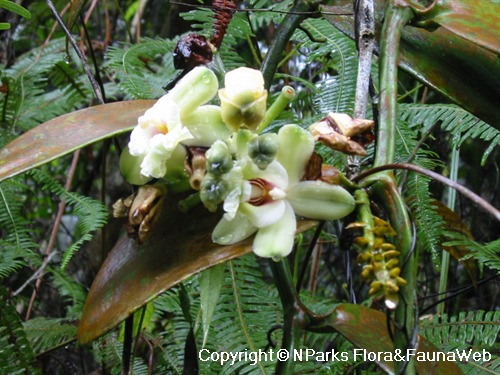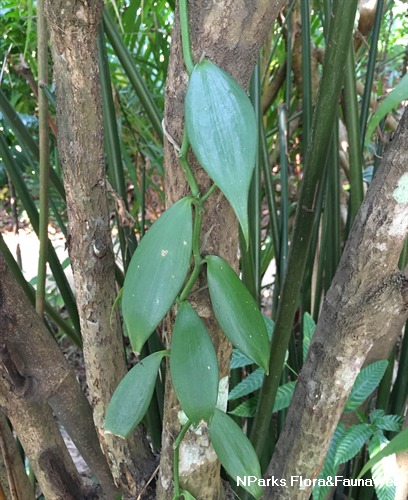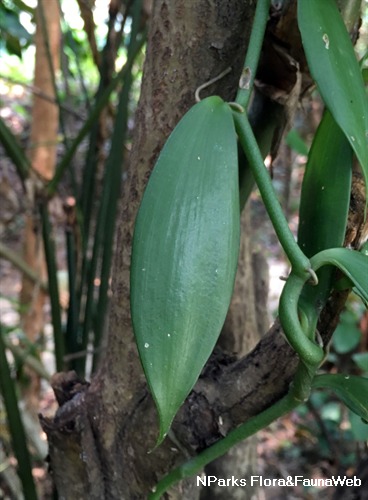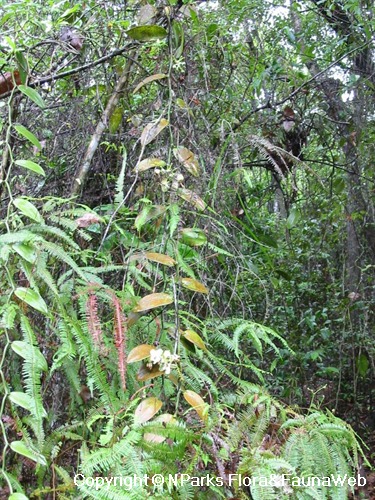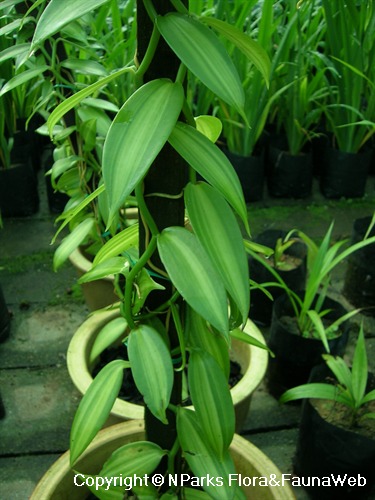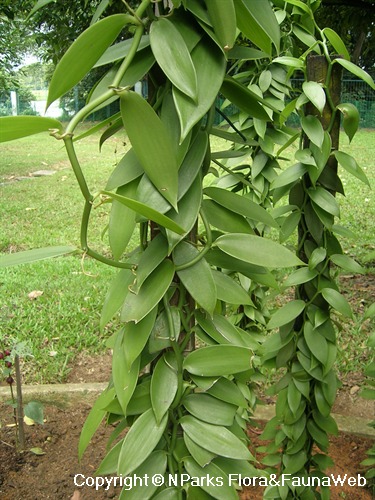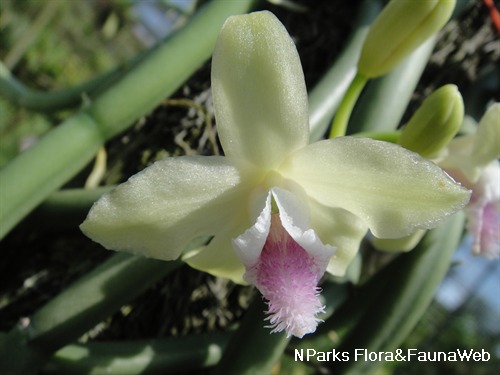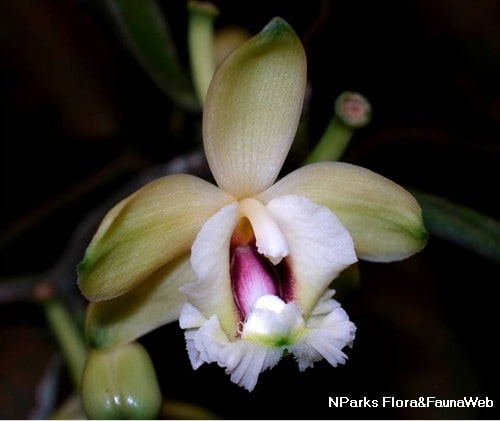
Back
Vanilla griffithii Rchb.f.
| Family Name: | Orchidaceae |
| Common Name: | Akar Penubal, Akar Telinah, Kerbau Bukit, Mengkapas |
Name
Classifications and Characteristics
| Plant Division | Angiosperms (Flowering Seed Plants) (Monocotyledon) |
|---|---|
| Plant Growth Form | Climber |
| Lifespan (in Singapore) | Perennial |
| Mode of Nutrition | Autotrophic |
Biogeography
| Native Distribution | Peninsular Malaysia, Singapore, and Karimun Island |
|---|---|
| Native Habitat | Terrestrial (Primary Rainforest, Secondary Rainforest, Freshwater Swamp Forest) |
| Preferred Climate Zone | Tropical |
| Local Conservation Status | Native to Singapore (Endangered (EN)) |
| CITES Protection | True |
Description and Ethnobotany
| Growth Form | It is a climber up to about 6 m long. |
|---|---|
| Foliage | Its alternate leaves may or may not be stalked. The leaves have fleshy leaf blades that are lance-shaped or egg-shaped-lance-shaped and 15 by 7.5 cm. |
| Flowers | The flowers are borne on an inflorescence which can bear up to 12 or more flowers. The flower sepals and petals are white with pale green tips. The flower lip is white with a pale yellow tip the side-lobes of the lip are broad and reflexed, showing the column. The midlobe is bilobed, with a thin and finely frilled edge and a v-shaped callus. The basal part of the flower lip has red-brown bands running along the inner surface. The flowers open widely when in bloom, up to 5 cm and last for a day. |
| Fruit | Its fruits are 5 cm long, ripening yellow, and 2.5 cm wide. |
| Habitat | It grows in forests. |
| Associated Fauna | Its flowers are insect-pollinated. |
| Cultivation | It can be propagated by seed or stem cutting. |
| Etymology | Latin vanilla, little-sheath; Latin griffithii, commemorating William Griffith (1810–1845), an English botanist. |
| Ethnobotanical Uses | Edible Plant Parts : Edible Fruits Food (Fruit or Vegetable): Its fruit is sweet and edible. Medicinal: Its flowers pulped in water may be used as an application to the body in violent fever. |
Landscaping Features
| Landscaping | It is suitable for parks as a climber on trees for its attractive flowers. |
|---|---|
| Desirable Plant Features | Ornamental Flowers |
| Landscape Uses | Parks & Gardens |
Fauna, Pollination and Dispersal
| Pollination Method(s) | Biotic (Fauna) |
|---|---|
| Seed or Spore Dispersal | Abiotic |
Plant Care and Propagation
| Light Preference | Semi-Shade |
|---|---|
| Water Preference | Little Water, Occasional Misting |
| Propagation Method | Seed, Stem Cutting |
Foliar
| Foliage Retention | Evergreen |
|---|---|
| Mature Foliage Colour(s) | Green |
| Mature Foliage Texture(s) | Glossy / Shiny, Thick |
| Foliar Type | Simple / Unifoliate |
| Foliar Arrangement Along Stem | Alternate |
| Foliar Attachment to Stem | Petiolate, Sessile |
| Foliar Shape(s) | Non-Palm Foliage (Oval, Lanceolate) |
| Foliar Venation | Parallel |
| Foliar Margin | Entire |
Floral (Angiosperm)
| Flower & Plant Sexuality | Bisexual Flowers |
| Flower Colour(s) | Green, White |
|---|---|
| Flower Grouping | Cluster / Inflorescence |
| Flower Location | Axillary |
| Flower Symmetry | Bilateral |
| Individual Flower Shape | Labiate / Lipped |
| Flower Size | 5 cm |
Fruit, Seed and Spore
| Mature Fruit Colour(s) | Yellow / Golden |
|---|---|
| Fruit Classification | Simple Fruit |
| Fruit Type | Dehiscent Dry Fruit , Capsule |
Image Repository
Others
| Master ID | 234 |
|---|---|
| Species ID | 1530 |
| Flora Disclaimer | The information in this website has been compiled from reliable sources, such as reference works on medicinal plants. It is not a substitute for medical advice or treatment and NParks does not purport to provide any medical advice. Readers should always consult his/her physician before using or consuming a plant for medicinal purposes. |

